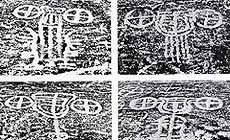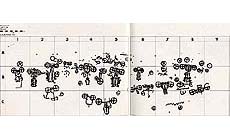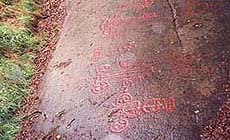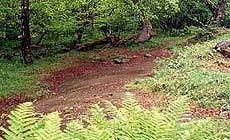|
|
|
|
|
|
| |
 |
Environment & Surface |
 |
 |
 |
|
Open-air
Shelter
Cave
Portable
Megalithic
|
Geography: |
Smooth sloping rock at a small, rather steep ridge surrounded by trees and bushes. Woodland, pasture. Wet area below the site. |
Proximity: |
Situated inland, close to the Frännarp farm. Possible stream in the wooden area below the rock during the Bronze Age. |
|
 |
Geology: |
Fine-grained, grey kind of rock. |
Surface: |
Smooth, vaulted sloping rock. Surface divided by a vertical line, weathered at the base of the rock. |
|
Dimensions:
|
Length 9.00 m.
Width 3.00 m.
|
|
 |
 |
|
|
|
|
| |
 |
Art |
 |
 |
 |
Description: |
Engravings
Paintings
Painted engravings
High or low-relief
Sculpture
Frännarp, Gryt parish, Scania. The Frännarp locality is situated inland and differs hereby from the main location of the South Skandinavian rock carvings which are found close to the sea or waterways during the Bronze age. There are about 20 chariots, of which 6 are drawn by pairs of horses. The chariots are two-wheeled and depicted turned out, so are the horses. The wheels have 4 spokes. There are a number of cup marks distributed over the rock surface.
|
Figures: |
total number 40
20 chariots
Wheel cross
Horses
Cup marks
|
|
 |
Chronology: |
Palaeolithic
Epipalaeolithic - Mesolithic
Neolithic
Copper Age
Bronze Age
Iron Age
Roman
Middle Age
Modern
Unknown
The Scanian rock carvings differ from those elsewhere in Scandinavia, the majority belongs to the close of the Stone Age, c. 2000 BC. The weapon figures can be dated to this period, and had their counterparts in the carvings of Central Europe. Some figures might even be older, especially those with similarities in the Megalithic ornamentation of the Middle Neolithic, c. 3200-2500 BC. The carvings of Frännarp and Drottninghall probably belong to Middle and Late Bronze Age, c. 1500-500 BC.
|
Notes: |
The Frännarp carving is unique, as the carved surface is covered by chariots, of which several are drawn by horses. These "battle-chariots" are drawn in a distinctive manner, where the picture is a kind of layout of carts and horses, clearly composed with the carts in a horizontal order (Burenhult 1989:240). |
|
 |
 |
|
| |
 |
Bibliography |
 |
|
|
|
|
| |
 |
Conservation |
 |
 |
 |
Status: |
Public
Private
Park
Classified site
|
Risk: |
The rock carvings are fragile and the major risk are chemical weathering, which makes the hard quartzite losen up and fall out, leaving white dots on the darker rock surface. Also natural weathering (mechanical weathering) during winter/spring, when water freeze in cracks and openings in the rock, creates major damage to rock faces with carvings. The biological weathering is also a danger to the rock carvings, and even to intense cleaning of the rock surface during documentation can make the rock fragile and expose the carvings to wind, water and air-born pollution. Occasionally the Frännarp carvings are covered with earth from the small earthen ridge at the top of the rock, and also by leaves and grass. |
|
 |
Conservation: |
Good
Quite good
Mediocre
Bad
|
Intervention: |
Problems concerning conservation and preservation, registration and documentation of rock carvings in Scandinavia are discussed by several departments, i.e. Riksantikvaren in Norway, Riksantikvarieämbetet in Sweden, several universities and research departments. Different methods are tested, for example covering of carved surfaces, measuring of temperature and different contents in water and air and also the composition in the granite. Hollows and cracks in the rock surface can be repaired and carefully filled in. The Frännarp carving is partly painted, although the colour is fading. |
|
 |
 |
|
|
 |
By |
 |
|
| |
| Record n. 763 / 807 |
No commercial use is allowed. Specific © is mentioned in the captions or owned by each Author or Institution |
|
| |
 |
EuroPreArt, European Prehistoric Art, is a web-based archaeological project funded by the European Union which aims to establish a lasting data-base of European prehistoric art documentation, to launch the base of an European institutional network and to contribute to the awareness of the diversity and richness of European Prehistoric Art.
It is proposed by: Instituto Politécnico de Tomar (IPT, Portugal),
CUEBC - European University Centre for Cultural Heritage (Italy - Europe),
Consejo Superior de Investigaciones Científicas (España),
Asociación Cultural Colectivo Barbaón (España),
Université de Liège (Belgique),
Gotland University College (Sverige),
University College Dublin (Eire),
Cooperativa Archeologica Le Orme dell'Uomo (Italia),
Study Centre and Museum of Prehistoric Art of
Pinerolo (Italia),
The European Centre for Prehistoric Research in the Alto Ribatejo (Portugal),
ArqueoJovem - a youth NGO (Portugal).
|
|
|
|
 |
|
 NEW: Alpine rock paintings
NEW: Alpine rock paintings





